
Tolbiac is a station of the Paris Métro. It is at the crossroads of two main roads, the Avenue d'Italie and the Rue de Tolbiac. It is near the Asian Quarter and the Parc de Choisy.

Maison Blanche station is a station of the Paris Métro, serving lines 7 and 14. South of this station, Line 7 forks into two branches, one leading to Villejuif–Louis Aragon and the other to Mairie d'Ivry. Since June 2024, it is an interchange with Line 14 running southwards to Aéroport d'Orly.

Maisons-Alfort–Les Juilliottes is a station on line 8 of the Paris Métro in the commune of Maisons-Alfort. It is named after the Juilliottes quarter of Maisons-Alfort.
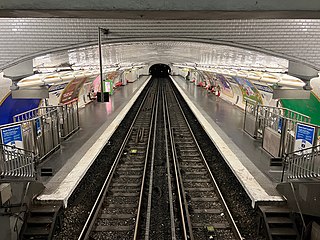
Ranelagh is a station on line 9 of the Paris Métro located in the 16th arrondissement.

Rue du Bac is a station on line 12 of the Paris Métro in the 7th arrondissement. It is named after the nearby rue du Bac, a street leading to a ferry (bac) across the Seine used in 1564 during the construction of the Tuileries Palace.

The Rue de la Paix is a fashionable shopping street in the centre of Paris. Located in the 2nd arrondissement, running north from the Place Vendôme and ending at the Opéra Garnier, it is best known for its jewellers, such as the shop opened by Cartier in 1898. Charles Frederick Worth was the first to open a couture house in the Rue de la Paix. Many buildings on the street are inspired in design by the hôtels particuliers of Place Vendôme.
Bibifoc (Seabert) is a 1985 French animated television series. It was created by BZZ Films in Paris and originally aired in French on Antenne 2, before being translated into different languages around the world. In the United States, the show aired on HBO starting in 1987. There were 26 episodes. The authors are: Marc Tortarolo for the theme, Philippe Marin for the design, and Jacques Morel with Éric Turlot for the stories.

This "quartier" of Paris got its name from the rue de la Chaussée-d'Antin in the 9th arrondissement of Paris. It runs north-northwest from the Boulevard des Italiens to the Église de la Sainte-Trinité.

Prostitution in France was legal until April 2016, but several surrounding activities were illegal, like operating a brothel, living off the avails (pimping), and paying for sex with someone under the age of 18.

Charenton–Écoles is a station on line 8 of the Paris Métro in the commune of Charenton-le-Pont. It is one of two métro stations located in the commune of Charenton-le-Pont, the other being Liberté on the same line. It is named after the commune the station is situated in, as well as the nearby Ecole élémentaire Aristide Briand located along Place Aristide-Briand
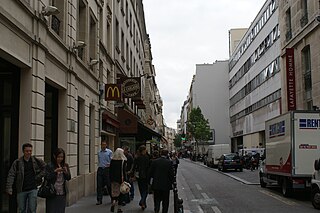
The Rue de Provence is a street in the 8th and 9th arrondissements of Paris. It begins at the Rue du Faubourg Montmartre and ends at the Rue de Rome. Only the short part of the street between the Rue du Havre and the Rue de Rome is in the 8th arrondissement.

The Rue de la Victoire is a street in the 9th arrondissement of Paris.
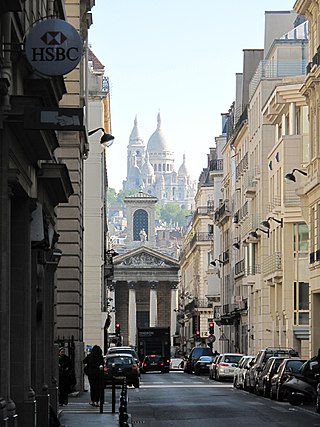
Rue Laffitte is a street in the 9th arrondissement of Paris, located near the Metro stations Richelieu - Drouot and Notre-Dame-de-Lorette.

Nicolas-Philippe Ledru, known as Comus, was a noted European physicist, prestidigitator and illusionist of the late 18th century. He had two sons, Jacques Philippe Ledru (1754–1832), a member of the French National Academy of Medicine and a mayor of Fontenay-aux-Roses, and Jacques Auguste Ledru, an inspector of pawn-shops. The latter was the father of Alexandre Auguste Ledru-Rollin, a lawyer and a French politician.

The Rue Saint-Lazare is a street in the 8th and 9th arrondissements of Paris, France. It starts at 9 Rue Bourdaloue and 1 Rue Notre-Dame-de-Lorette, and ends at Place Gabriel-Péri and Rue de Rome.
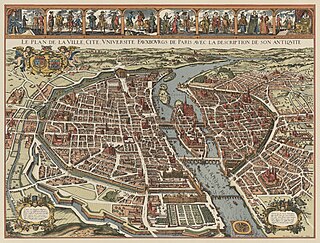
Dictionnaire historique des rues de Paris is a book by Jacques Hillairet, a historian specializing in the history of Paris. It includes 5344 streets in two volumes and 2343 illustrations. It was first published in 1960 by éditions de Minuit and was regularly re-published and updated from 1963 onwards. His sources included Dictionnaire administratif et historique des rues de Paris et de ses monuments by Louis and Félix Lazare and Histoire de Paris rue par rue, maison par maison by Charles Lefeuve.

Auguste André Coussillan was a French historian specialising in the history of Paris. Under the pen-name Jacques Hillairet he wrote two major reference works on the subject in the 1950s - Connaissance du vieux Paris and Dictionnaire historique des rues de Paris.
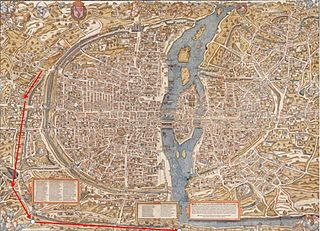
The Menilmontant brook is an old and small river in Paris.
The authorities of medieval Paris attempted to confine prostitution to a particular district. Louis IX (1226–1270) designated nine streets in the Beaubourg Quartier where it would be permitted. In the early part of the 19th century, state-controlled legal brothels started to appear in several French cities. By law, they had to be run by a woman, and their external appearance had to be discreet. The maisons were required to light a red lantern when they were open, and the prostitutes were only permitted to leave the maisons on certain days and only if accompanied by its head. By 1810, Paris alone had 180 officially approved brothels.
Prostitution in Paris, both in street form and in dedicated facilities has had a long history and remains present to this day.



















